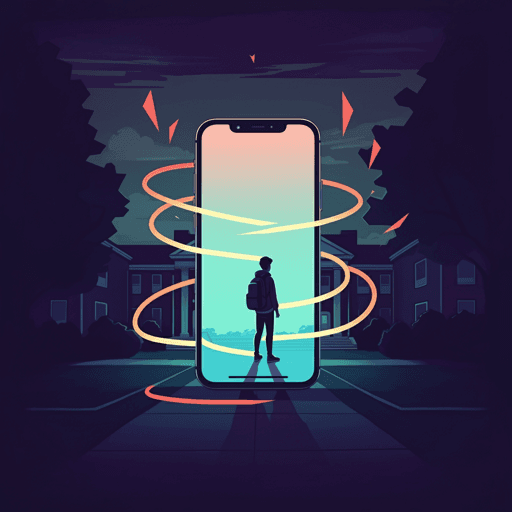
Psychology
The impact of social isolation on smartphone addiction among college students: the multiple mediating effects of loneliness and COVID-19 anxiety
Y. Wang and Q. Ma
During COVID-19 campus lockdowns, social isolation drove smartphone addiction among college students largely through loneliness and COVID-19 anxiety. This study uses a multiple mediation model to map direct and indirect (parallel and sequential) pathways and suggests interventions targeting loneliness and anxiety. This research was conducted by Ye Wang and Qianying Ma.
~3 min • Beginner • English
Introduction
The study investigates how social isolation during COVID-19 relates to smartphone addiction among Chinese college students, and whether loneliness and COVID-19 anxiety serve as mediating mechanisms. With 1.076 billion mobile internet users in China and heavy smartphone use among college students, excessive use has been linked to psychological and behavioral dysfunctions. Pandemic-related campus restrictions (closed management, social distancing, prohibited gatherings) likely intensified smartphone reliance and addiction. Prior work has identified social isolation as an antecedent of smartphone addiction, but comprehensive models integrating loneliness and anxiety are limited. Guided by compensatory internet use theory (CIU), which posits individuals engage in online activities to alleviate real-world distress, the study hypothesizes that social isolation predicts smartphone addiction and that loneliness and COVID-19 anxiety mediate this relationship in parallel and sequential forms. It aims to clarify direct links and mediating processes during a public health crisis.
Literature Review
The literature differentiates smartphone addiction from overuse or dependence, characterizing it as a behavioral addiction impairing psychological, physiological, and social functioning. Social isolation includes objective factors (living alone, limited contact) and subjective feelings (not belonging), and has consistently been associated with problematic smartphone use, including during COVID-19. CIU suggests individuals use smartphones to compensate for loneliness and anxiety, potentially leading to addiction. Empirical findings link loneliness to increased smartphone addiction and demonstrate elevated anxiety during infectious disease outbreaks. During COVID-19, strict isolation has been tied to higher anxiety and increased smartphone reliance. The study posits nine hypotheses: social isolation positively relates to smartphone addiction (H1), loneliness (H2), and COVID-19 anxiety (H5); loneliness positively relates to smartphone addiction (H3) and COVID-19 anxiety (H8); COVID-19 anxiety positively relates to smartphone addiction (H6); loneliness and COVID-19 anxiety each mediate the social isolation–addiction link (H4, H7); and these mediators operate both in parallel and sequentially (H9). The multiple mediation model considers both parallel and sequential pathways, with indirect evidence suggesting loneliness can precede anxiety, and potentially bidirectional relations.
Methodology
Design: Cross-sectional online survey with quota proportional sampling across eight higher education institutions in Conghua District (Guangzhou), a suburban area with strict campus closures during the late-2022 COVID-19 resurgence. Recruitment and timing: Questionnaire Star link distributed via university WeChat groups; data collected Dec 10–15, 2022. Sample: 900 responses; after excluding invalid cases (completion time <100s; patterned responses), 868 valid responses (620 female, 248 male), primarily aged 18–25. Measures: 29-item questionnaire covering demographics, social isolation, loneliness, COVID-19 anxiety, and smartphone addiction. - Social isolation: Nicholson et al. (2020) scale, 6 items across subjective feelings (3 items; 5-point Likert: 1=never to 5=always) and objective states (3 items; frequency of contacts via in-person and electronic communication; 5-point scales reflecting counts). - Loneliness: 3-item Hughes et al. (2008) short scale (e.g., lack of companionship), 5-point Likert (1=never to 5=always). - COVID-19 anxiety: 5 items adapted from Yıldırım et al. (2022) assessing apprehension/worry about health, infection, future, life impacts; 5-point Likert (1=strongly disagree to 5=strongly agree). - Smartphone addiction: 10-item short Smartphone Addiction Scale (Kwon et al., 2013) (e.g., missing planned work, difficulty concentrating), 5-point Likert (1=strongly disagree to 5=strongly agree). Analysis: SPSS 27 for descriptive statistics, normality, and correlations; AMOS 24 for confirmatory factor analysis (CFA) and structural equation modeling (SEM) to test direct effects and model fit; Hayes PROCESS v4.1 Model 6 for multiple mediation with bootstrapping (5,000 resamples), examining parallel and sequential mediation; exploratory reverse mediation model also tested. Ethics: Approved by the Academic Ethics Committee of Nanfang College - Guangzhou; anonymity and voluntary participation assured.
Key Findings
Sample characteristics: Majority aged 18–25 (97.8%); females 71.4%; grade distribution across freshman to senior; living expenses most commonly 1000–1500 CNY (38.9%) and 1500–2000 CNY (30.3%). Normality: Skewness and kurtosis within –2 to 2 for focal variables. Descriptive statistics and correlations (N=868): Means (M) and SDs: Social isolation (IS) M=3.862 (SD=0.888), Loneliness (LO) M=3.762 (SD=1.017), COVID-19 anxiety (AN) M=3.744 (SD=0.938), Smartphone addiction (AD) M=3.780 (SD=0.939). Significant positive correlations among IS, LO, AN, AD ranging from 0.583 to 0.690 (p<0.01). Variance analysis: Smartphone addiction level high (mean=3.78). Significant differences by college (F=2.937, p≤0.01), monthly living expenses (F=3.277, p<0.05), and grade (F=5.059, p<0.01); no significant differences by gender or age. Highest addiction means: Guangdong Engineering Polytechnic (4.06), Guangdong Polytechnic of Water Resources and Electric Engineering (3.90), Software Engineering Institute of Guangzhou (3.83). Seniors (3.94) and freshmen (3.84) higher than sophomores and juniors. Reliability and validity: Cronbach’s alpha >0.7 for all constructs; CFA model fit excellent: χ²(246)=507.875, χ²/df=2.605; RMSEA=0.035; CFI=0.985; TLI=0.984; SRMR=0.023. Convergent validity: AVE 0.639–0.725; CR >0.7. Discriminant validity supported (square roots of AVE > inter-construct correlations). Structural model fit: χ²(246)=507.875, χ²/df=2.065; RMSEA=0.035; CFI=0.951; TLI=0.939; SRMR=0.023. Direct paths (supporting H1, H3, H6): IS→AD β=0.215 (t=5.68, p<0.001); LO→AD β=0.271 (t=7.142, p<0.001); AN→AD β=0.42 (t=11.11, p<0.001). Predictors of mediators (supporting H2, H5, H8): IS→LO β=0.674 (t=18.048, p<0.001); IS→AN β=0.416 (t=9.674, p<0.001); LO→AN β=0.365 (t=8.578, p<0.001). Mediation analyses (PROCESS Model 6; 5,000 bootstraps): Total effect IS→AD β=0.665 (SE=0.028; 95% CI [0.610, 0.721]); Direct effect β=0.243 (SE=0.032; 95% CI [0.180, 0.305]) accounting for 36.5% of total; Total indirect effect β=0.423 (SE=0.028; 95% CI [0.366, 0.477]) accounting for 63.5%. Specific indirect effects: IS→LO→AD β=0.165 (SE=0.024; 95% CI [0.120, 0.213]) = 24.8%; IS→AN→AD β=0.171 (SE=0.023; 95% CI [0.126, 0.217]) = 25.7%; Sequential IS→LO→AN→AD β=0.087 (SE=0.015; 95% CI [0.059, 0.119]) = 13.1% (supports H9). Reverse sequential mediation: IS→AN→LO→AD β=0.057 (SE=0.012; 95% CI [0.035, 0.083]) = 8.5%; individual indirect effects: via AN β=0.256 (SE=0.028; 95% CI [0.203, 0.311]) and via LO β=0.109 (SE=0.017; 95% CI [0.077, 0.144]). Overall, loneliness and COVID-19 anxiety mediate IS→AD both in parallel and sequentially, with larger indirect than direct effects.
Discussion
Findings confirm that social isolation directly increases smartphone addiction among college students and operates largely through psychological mechanisms: loneliness and COVID-19 anxiety. Both mediators function in parallel, consistent with CIU and uses-and-gratifications perspectives, whereby students use smartphones for information, social connection, distraction, and emotion regulation during isolation. Sequential mediation indicates that social isolation fosters loneliness, which elevates anxiety, further driving addiction; a reverse sequence, where anxiety heightens loneliness and then addiction, also holds, suggesting bidirectionality between loneliness and anxiety. The indirect effects (63.5% of total) exceed the direct effect, highlighting subjective psychological states as core drivers of problematic smartphone use under campus isolation. These results address the study’s research questions by demonstrating predictive links and mediating processes, and they underscore the importance of mental health supports to mitigate loneliness and anxiety, thereby reducing addiction risk. Practical implications include enhancing psychological counseling, mental health education, social interaction skills training, and providing comprehensive COVID-19 information to reduce anxiety in similar future public crises.
Conclusion
Social isolation among college students significantly predicts smartphone addiction, both directly and through loneliness and COVID-19 anxiety acting as parallel and sequential mediators. A reverse sequential pathway (anxiety→loneliness) also emerged. The study advances theoretical understanding of smartphone addiction antecedents during public health crises and provides practical guidance: interventions should target loneliness and anxiety arising from isolation and social distancing. Future research should employ longitudinal or experimental designs to establish causality and explore additional factors (e.g., social support, sense of control) influencing smartphone addiction.
Limitations
- Cross-sectional design prevents causal inference; longitudinal or experimental studies are needed. - Nonprobability quota sample from Conghua District limits generalizability; probability sampling across broader regions is recommended. - Self-report measures risk social desirability and measurement bias; participants may underreport problematic behaviors. Employ experience sampling and objective log data in future work. - Potential bidirectional effects among loneliness, anxiety, and smartphone addiction were not fully disentangled; cross-lagged analyses are warranted. - Omitted variables (e.g., social support, sense of control) may influence outcomes; incorporating these can yield a more comprehensive model.
Related Publications
Explore these studies to deepen your understanding of the subject.







